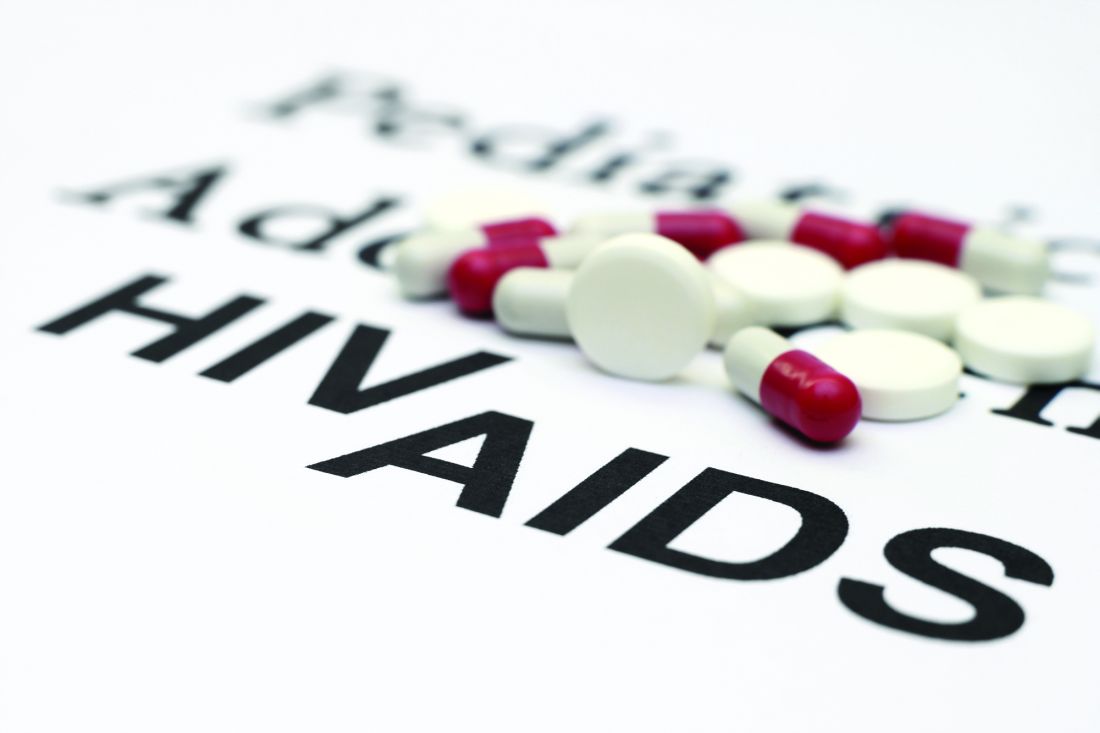User login
A great volume of HIV and AIDS research enters the medical literature every month. It’s difficult to monitor everything, so here’s a quick look at some notable news items and journal articles published over the past few weeks.
A study in the American Journal of Pathology found that HIV impairs Mycobacterium tuberculosis antigen presentation in human dendritic cells, thereby suppressing an important cell-linking innate and adaptive immune response in TB.
A study of the uptake of HIV preexposure prophylaxis (PrEP) among commercially insured persons in the U.S. found that interventions are needed to increase PrEP use by women at substantial risk of acquiring HIV infection.
Implementation of proper and integrated malaria preventive measures as well as frequent monitoring of anemia on prescription of antiretroviral therapy could likely improve the health conditions of HIV-infected children, according to a study in Cameroon.
A Colombian study of the clinical outcomes of a generic version of abacavir/lamivudine and efavirenz in HIV treatment naive patients showed the expected safety and effectiveness profile of proprietary antiretroviral drugs.
Skin autofluorescence is increased in HIV-infected subjects and related with smoking, low nadir CD4 count, and men who have sex with men, according to a study in the journal AIDS, but researchers say larger studies are needed to confirm whether skin autofluorescence is an independent predictor of cardiovascular disease events.
Researchers at Vanderbilt University, Nashville, Tenn., said that, as the HIV-positive population ages, structured subjective cognitive assessment may be beneficial to identify the early signs of cognitive impairment, and to allow for earlier interventions to maintain cognitive performance.
An antiretroviral therapy roll-out in rural Malawi resulted in a sustained 10-year gain in adult life expectancy for HIV-positive individuals, according to a study in the International Journal of Epidemiology.
Increasing HIV virulence driven by universal testing and treatment is likely not a major public health concern, according to a modeling study, but should be monitored in sentinel surveillance, in a manner similar to transmitted resistance to antiretroviral drugs.
A South African study found no association between duration of tenofovir exposure in utero and early linear growth in HIV-exposed, uninfected infants.
In 2014, 17.9% of AIDS cases reported by 29 countries in the European Union and European Economic Area (EU/EEA) presented with TB as an AIDS-defining illness, indicating that TB/HIV coinfection is a substantial problem in the EU/EEA.
A study of malnourished antiretroviral therapy (ART)-eligible adults in sub-Saharan Africa found that pre-ART mortality was twice that in the early post-ART period, suggesting many early ART deaths represent advanced HIV disease rather than treatment-related events.
A study in Taiwan found that HIV patients had an increased risk of stroke, particularly those with cryptococcal meningitis, cytomegalovirus, or P. marneffei infection.
A study of older patients living with HIV found that the associations between cognitive impairment and patient-reported outcome measures were weak, possibly because impairment was mild and therefore largely asymptomatic.
[email protected]
On Twitter @richpizzi
A great volume of HIV and AIDS research enters the medical literature every month. It’s difficult to monitor everything, so here’s a quick look at some notable news items and journal articles published over the past few weeks.
A study in the American Journal of Pathology found that HIV impairs Mycobacterium tuberculosis antigen presentation in human dendritic cells, thereby suppressing an important cell-linking innate and adaptive immune response in TB.
A study of the uptake of HIV preexposure prophylaxis (PrEP) among commercially insured persons in the U.S. found that interventions are needed to increase PrEP use by women at substantial risk of acquiring HIV infection.
Implementation of proper and integrated malaria preventive measures as well as frequent monitoring of anemia on prescription of antiretroviral therapy could likely improve the health conditions of HIV-infected children, according to a study in Cameroon.
A Colombian study of the clinical outcomes of a generic version of abacavir/lamivudine and efavirenz in HIV treatment naive patients showed the expected safety and effectiveness profile of proprietary antiretroviral drugs.
Skin autofluorescence is increased in HIV-infected subjects and related with smoking, low nadir CD4 count, and men who have sex with men, according to a study in the journal AIDS, but researchers say larger studies are needed to confirm whether skin autofluorescence is an independent predictor of cardiovascular disease events.
Researchers at Vanderbilt University, Nashville, Tenn., said that, as the HIV-positive population ages, structured subjective cognitive assessment may be beneficial to identify the early signs of cognitive impairment, and to allow for earlier interventions to maintain cognitive performance.
An antiretroviral therapy roll-out in rural Malawi resulted in a sustained 10-year gain in adult life expectancy for HIV-positive individuals, according to a study in the International Journal of Epidemiology.
Increasing HIV virulence driven by universal testing and treatment is likely not a major public health concern, according to a modeling study, but should be monitored in sentinel surveillance, in a manner similar to transmitted resistance to antiretroviral drugs.
A South African study found no association between duration of tenofovir exposure in utero and early linear growth in HIV-exposed, uninfected infants.
In 2014, 17.9% of AIDS cases reported by 29 countries in the European Union and European Economic Area (EU/EEA) presented with TB as an AIDS-defining illness, indicating that TB/HIV coinfection is a substantial problem in the EU/EEA.
A study of malnourished antiretroviral therapy (ART)-eligible adults in sub-Saharan Africa found that pre-ART mortality was twice that in the early post-ART period, suggesting many early ART deaths represent advanced HIV disease rather than treatment-related events.
A study in Taiwan found that HIV patients had an increased risk of stroke, particularly those with cryptococcal meningitis, cytomegalovirus, or P. marneffei infection.
A study of older patients living with HIV found that the associations between cognitive impairment and patient-reported outcome measures were weak, possibly because impairment was mild and therefore largely asymptomatic.
[email protected]
On Twitter @richpizzi
A great volume of HIV and AIDS research enters the medical literature every month. It’s difficult to monitor everything, so here’s a quick look at some notable news items and journal articles published over the past few weeks.
A study in the American Journal of Pathology found that HIV impairs Mycobacterium tuberculosis antigen presentation in human dendritic cells, thereby suppressing an important cell-linking innate and adaptive immune response in TB.
A study of the uptake of HIV preexposure prophylaxis (PrEP) among commercially insured persons in the U.S. found that interventions are needed to increase PrEP use by women at substantial risk of acquiring HIV infection.
Implementation of proper and integrated malaria preventive measures as well as frequent monitoring of anemia on prescription of antiretroviral therapy could likely improve the health conditions of HIV-infected children, according to a study in Cameroon.
A Colombian study of the clinical outcomes of a generic version of abacavir/lamivudine and efavirenz in HIV treatment naive patients showed the expected safety and effectiveness profile of proprietary antiretroviral drugs.
Skin autofluorescence is increased in HIV-infected subjects and related with smoking, low nadir CD4 count, and men who have sex with men, according to a study in the journal AIDS, but researchers say larger studies are needed to confirm whether skin autofluorescence is an independent predictor of cardiovascular disease events.
Researchers at Vanderbilt University, Nashville, Tenn., said that, as the HIV-positive population ages, structured subjective cognitive assessment may be beneficial to identify the early signs of cognitive impairment, and to allow for earlier interventions to maintain cognitive performance.
An antiretroviral therapy roll-out in rural Malawi resulted in a sustained 10-year gain in adult life expectancy for HIV-positive individuals, according to a study in the International Journal of Epidemiology.
Increasing HIV virulence driven by universal testing and treatment is likely not a major public health concern, according to a modeling study, but should be monitored in sentinel surveillance, in a manner similar to transmitted resistance to antiretroviral drugs.
A South African study found no association between duration of tenofovir exposure in utero and early linear growth in HIV-exposed, uninfected infants.
In 2014, 17.9% of AIDS cases reported by 29 countries in the European Union and European Economic Area (EU/EEA) presented with TB as an AIDS-defining illness, indicating that TB/HIV coinfection is a substantial problem in the EU/EEA.
A study of malnourished antiretroviral therapy (ART)-eligible adults in sub-Saharan Africa found that pre-ART mortality was twice that in the early post-ART period, suggesting many early ART deaths represent advanced HIV disease rather than treatment-related events.
A study in Taiwan found that HIV patients had an increased risk of stroke, particularly those with cryptococcal meningitis, cytomegalovirus, or P. marneffei infection.
A study of older patients living with HIV found that the associations between cognitive impairment and patient-reported outcome measures were weak, possibly because impairment was mild and therefore largely asymptomatic.
[email protected]
On Twitter @richpizzi

